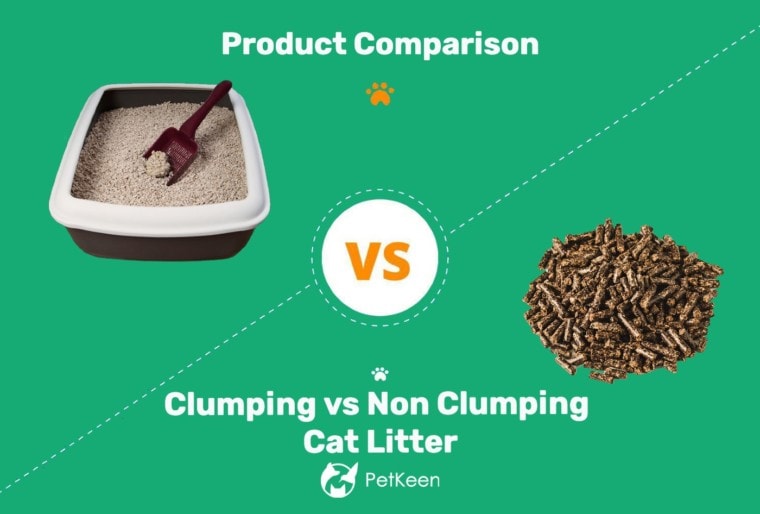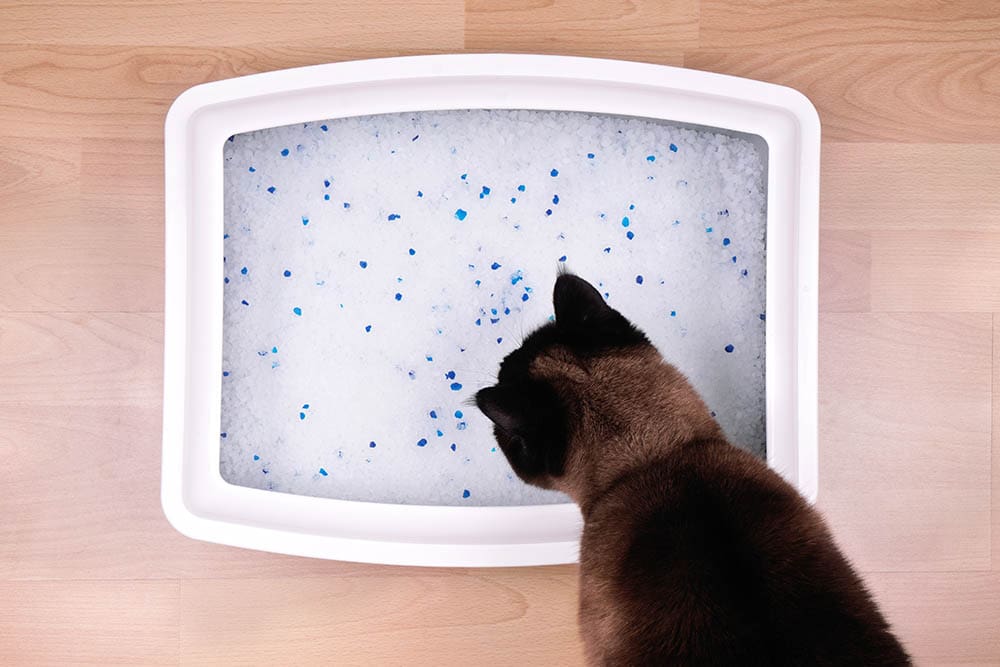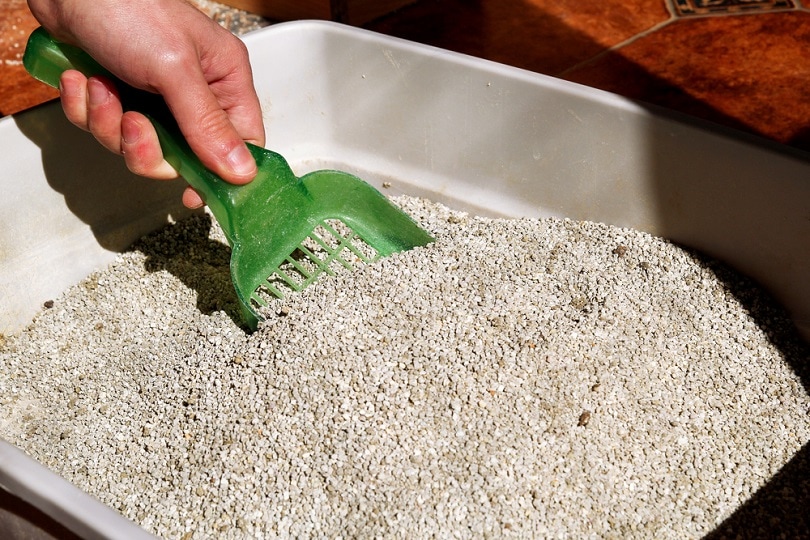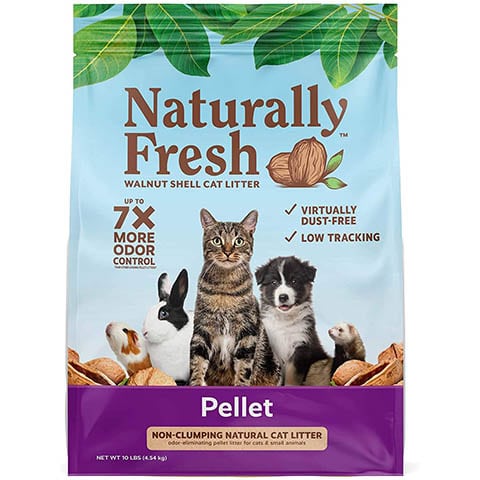
Click to Skip Ahead
One of the biggest decisions cat owners have is whether to use clumping or non-clumping cat litter. There are pros and cons to both kinds, but which one is best for you? It’s not uncommon for people to buy cat litter without knowing or thinking about what they need out of it, only to be disappointed when it’s not meeting their needs. For this reason, we’re going to break down the two types of litter, including their strengths and weaknesses, so you can determine which type you need.
Overview of Non-Clumping Cat Litter
Non-clumping cat litter is the cat litter that started it all. It’s been around long before any clumping cat litters were developed, and it’s available in a wide variety of materials that don’t have clumping capabilities. Examples include corn, crystals, grass, clay, and wood.
If you are willing to give up clumping capabilities in your cat litter, there are a lot more unique and exotic materials available to choose from. But what does this mean for you in terms of odor control, dust, litter lifespan, moisture absorption, or other variables?
How non-clumping cat litter works
The most absorbent options for non-clumping cat litter are made from clay. While it doesn’t clump, it still has a ton of moisture-absorbing capability before it becomes overwhelming. Crystal cat litters are known for great odor control, but they’re not extra absorbent, so you’re giving up absorbency for less smell.
As a rule, non-clumping litter works the same as clumping litter–except it doesn’t clump. This can be a positive or a negative, depending on your preference.

Why choose non-clumping cat litter
The tradeoff for most “natural” non-clumping cat litter is that you get a better-smelling litter for the environment. Non-clumping litter is also more lightweight, has less dust, and avoids tracking out of the box.
For the budget-conscious cat owner, non-clumping litter is typically cheaper than clumping litter. Because there are so many material options, there is a ton of freedom in how much you spend.
By some standards, non-clumping litter is lower maintenance than clumping cat litter because you don’t have to remove the clumps. You leave the cat litter alone until you empty the litter box.
There are both benefits and weaknesses to non-clumping cat litter. Cat litter that clumps typically does a better job of removing or “locking in” waste odors for a longer period. Clumps also make cat waste easier to remove, which allows you to remove sources of odor while prolonging the life of the litter.
With non-clumping cat litter, your litter life is shorter because you can’t clean it. You have to simply let the litter run its course and dump the entire batch. The side effect of this is that you must leave the litter until it’s too smelly to continue. The fact that you use the cat litter odor to determine when your litter needs changing can be a turn-off for some users.
Overview of Clumping Cat Litter
There are still a few different materials to choose from for clumping cat litter, but the selection is a lot less than non-clumping. Most of the specialty and natural material options don’t have clumping capabilities, so you won’t be able to enjoy those benefits if you want a clumping litter.
The most popular material for clumping cat litter is clay. While it is the cheapest litter material, clumping varieties still cost more than non-clumping ones.
Heavy clay use in clumping cat litter means dust and tracking levels are higher, and the litter itself is very heavy.

Why choose clumping cat litter
The most obvious benefit of clumping cat litter is, of course, the fact that it clumps. Controlling odor is much easier, and you don’t have to continually monitor the litter box for smell; you simply remove the clumps regularly.
Clumping litter can still be very absorbent, and many varieties are capable of fighting off liquid waste just as well as non-clumping ones, just with the added benefit of forming hard clumps around the waste material.
Other factors to consider when choosing your cat litter
Now that we’ve looked at the differences between non-clumping and clumping cat litter let’s consider some things to consider before making a purchase. Solid waste is easily removed from either type of litter, so we’re going to focus on wet waste for this discussion.
There are two important considerations when choosing a cat litter:
1. Cats aren’t tidy (when using the litter box)
Most cats who use a litter box will fling and throw the litter around after they’ve done their business. What this means is that they will fling particles of litter onto your floor and around the room. With non-clumping cat litter, you don’t remove the soiled particles on a regular basis, so they’re all mixed together. You can’t differentiate between clean and soiled particles of litter. Therefore, some soiled particles will end up out of the litter box.
2. Cats are hygienic creatures by nature
Cats are notoriously clean animals and have been known to refuse using a litter box that they don’t deem to be “clean enough.” The way cats detect cleanliness is by smell. Even a litter box that doesn’t smell like cat urine to you will smell like urine to your cat if it’s not removed. Non-clumping cat litter will have to be changed fairly regularly to avoid smells and make sure your cat keeps using the litter box.
No matter what kind of litter you use, bad smells often linger. That's where an effective litter additive like Hepper's Advanced Bio-Enzyme Cat Litter Deodorizer can make a big difference.
- Bio Enzymatic Cat Litter Freshener - Smart formulation uses natural ingredients eliminating cat...
- Save Money - Stuff for cats isn’t the cheapest. With this litter box odor eliminator, you’ll...
- Every Litter, Every Surface - Are you afraid this additive won’t work on your litter? Fear not!...
This biodegradable deodorizer is fragrance-free and safe for all ages of cats and types of litter. It uses bio-enzymes to naturally get rid of odors and help your litter last longer.
At Pet Keen, we've admired Hepper for many years, and decided to take a controlling ownership interest so that we could benefit from the outstanding designs of this cool company!
Quick Look: Our Top Choices
Our Favorite Non-Clumping Cat Litter: Blue Buffalo Naturally Fresh Walnut-Based Pellet Non-Clumping Cat Litter
Made from all-natural walnut materials, this non-clumping cat litter is highly absorbent and virtually dust-free. The dust-free feature is a bonus for cats with sensitive respiratory systems, and this litter is free of any chemical additives.
The pellet design does track to some degree, and as with any non-clumping litter, it will start to smell over time.
Our Favorite Clumping Cat Litter: Arm & Hammer Slide Scented Clumping Clay Cat Litter
As the brand name implies, Arm & Hammer Slide cat litter contains baking soda to prevent litter box odors. Slide litter is not just clumping litter, but it also doesn’t stick to the bottom of your litter box, making cleanup a breeze. You can scoop clumps out daily, and the litter slides straight into the garbage when it’s time to change it.
While clumping cat litter is known for dust and tracking, this one is dust-free and tracks very little.
Summary
The choice of whether to use non-clumping or clumping cat litter is a personal one. Which one you choose depends on how much maintenance you want to do, how much you want to spend, and how picky your cat is.
- Next on your reading list: Crystal Litter Vs Clumping Cat Litter: What’s Best For My Cat?
Featured Image Credit: (Left) Axel Bueckert, Shutterstock, (Right) Amazon










